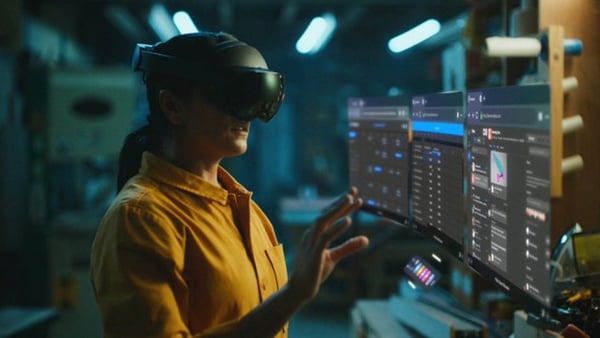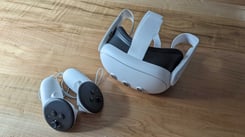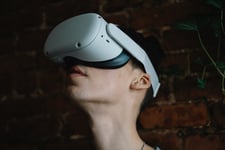Meta has positioned itself as one the best creators of mobile VR Headsets with the popular Quest line of headsets. These headsets stand out from the rest of the VR competition as being entirely standalone headsets, allowing you to experience VR without the need for an external phone, PC or sensors to track your movements. This all came along with a pretty affordable price tag that gave a lot of people the opportunity to have VR in their lives and businesses. They have been the headsets of choice for practical architecture presentations among those who understand the value of mobile VR for clients for several years.
The last iteration of the headset was the Meta Quest 2, which came out in 2020. Over the past year and a half, rumors and speculation have all risen around how Meta would follow up on the previous two Quest headsets. Especially amid the rise of the “Metaverse”. The speculation is at an end as Meta announced the Meta Quest Pro recently. The new high-end VR headset comes with features specifically made for use in business (especially remote meetings) and to facilitate new social features. Perhaps most importantly for business and architecture presentations, there is a much heavier focus on Augmented Reality, which has interesting implications for architects placing objects in the real world so their clients can see them in context.
So what new features are available in the Meta Quest Pro that will benefit architects and designers? We offer a breakdown of the new features and where/with whom this headset will flourish.
New Features of the Meta Quest Pro
The Meta Quest Pro maintains the many unique features of the original Quest line. However, there is a new suite of new features aimed at improving the social interaction capabilities of the device and increasing its potential for showing off AR. It seems that AR is the main focus of this device based on some of the new features now included.
Full-Color Passthrough and Increased AR Capabilities
Included in the original Quest line was a feature called “passthrough”. Passthrough allowed one to see their physical surroundings while still wearing the headset, thanks to the external cameras on the device that tracked the headset’s movements. The camera would turn on if the wearer left the safe area they had marked in the room to show them where they were, or activated by the wearer’s choice if they tapped the side of the headset. In Meta Quest 1 and 2, this was a low-quality black-and-white view that was just for safety and a quick check of one’s surroundings.
In the Meta Quest Pro, Passthrough has been improved significantly and is now a key feature instead of a safety check. Passthrough has been upgraded to full-color video and the quality has been vastly improved to mimic more natural view angles and quicker response. And what value or use cases are likely to come from this change? Meta has decided to fully expand the AR capabilities of the Meta Quest Pro, allowing for AR experiences to take place in your surroundings. Front cameras that allow users and clients to see their space are critical for placing an object in the context of the real world, a key element of presenting with AR for architects and designers.

An example of the AR Capabilities of the Meta Quest Pro (Image Courtesy: Meta)
With VR goggles that seamlessly allow a full-color high-quality view of the real world, an AR experience can be a much more immersive and natural experience. Your viewpoint isn’t limited to something the size of a phone screen and can be more easily examined. We’ve started to see how certain apps are using the Meta Quest Pro to create AR experiences such as projecting external monitors and screens off of a computer, eliminating the need for multiple monitors in a computer setup. We’ve also seen manufacturers create AR experiences to show off larger structures than usual. Allowing people to walk around and even go inside virtual AR structures. At Yulio, we are very excited to see where architects will go with these new AR capabilities in the Meta Quest Pro as we believe AR is a key to the future of immersive client presentations.
A Focus on Business, Socializing, and Collaboration
The recent entries in the Meta Quest line of headsets focused on appealing to a broad audience. They were available to those interested in VR as a hobby or casual users as well as those who wanted a simple presentation method for business. The headsets offered great introductory VR experiences and an easy setup for gaming, marketing and simple sharing.
The Meta Quest Pro however is looking to move away from the casual, gaming, and hobbyist audience that the previous two iterations targeted. As the name suggests, the Meta Quest Pro is aimed at professionals from across many different industries. In its marketing, during the announcement, we saw it being used by musicians, designers, remote workers, and more. Meta showcased both AR and VR features specifically being used as work tools, instead of being used for gaming or other activities. This could have significant implications for making VR and AR a more typical part of practical business presentations.
Eye and mouth-tracking
Horizon Worlds (the virtual spaces inside the metaverse) has been a major focus for Meta over the past year. They’ve invested heavily in their virtual work features by creating meeting spaces within the Metaverse. They’ve been continuously updating their Avatar features to allow people to more accurately represent themselves physically in the virtual world. A new feature of the Meta Quest Pro seems particularly aimed at expanding the world, with both eye and mouth tracking.
In terms of VR experiences, eye tracking can help create better picture quality and help keep up with the user’s movement and vision angle. Mouth tracking, however, is a newer feature. Both can be used together in Meta’s Horizon Worlds to move the lips and eyes of your Avatar in a more realistic way. This means someone in a virtual environment can make true eye contact with you and when they speak it will look like their avatar is accurately saying their speech. All of this is to increase the realistic social interaction aspect of Meta’s vision for Horizon Worlds and make virtual meetings feel more natural.
![]()
The Avatars from Horizon Worlds can be quite accurate representations of yourself. (Image Courtesy: Meta)
A High-End Price for Professionals
As we’ve mentioned, Meta is marketing the Meta Quest Pro as a high-end device for professionals in working environments, and with that comes a more expensive price of USD 1,499.99, about three times more than the current model. This price is reflective of all the new tech that has gone into the device (the new external cameras and tracking tech likely increased the price dramatically), as well as the new accessories including updated controllers, light blockers, and a new charging dock for both headset and controllers. This might mean that the controllers will no longer need extra batteries.
This is certainly a departure from the previous Quest devices that had efficient pricing, making the cost of VR a lower barrier to many. However, the more expensive headset, when amortized over multiple meetings in a professional setting may well be worthwhile - not so much for the metaverse as for its increased focus on AR.
The Future of The Meta Quest Pro
Overall, we here at Yulio are very excited to finally see the new entry in the Meta Quest line of VR/AR devices. Despite the new higher price tag, the new AR features of the headset will allow designers, architects, and more to take advantage of the new tech to collaborate and create. The original Meta Quest was a game-changer that opened the door to some pretty astounding VR experiences for a lot of people. Will the Meta Quest Pro be the tool for businesses that Meta wants it to be? Make sure to follow our updates as we follow the launch of the Meta Quest Pro.
Does the idea of businesses using VR still sound new to you? Well, rest assured, many businesses are actively using VR these days in some exciting ways. Check out our Top Uses of Business Ready VR whitepaper to get an idea of how you can get started with the tech yourself.






.jpg?width=245&height=150&name=BUSINESS-READY-VR-63-1%20(1).jpg)
